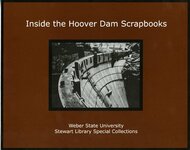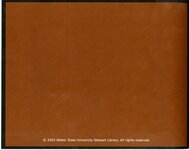| Title |
2003-1 Inside the Hoover Dam Scrapbooks |
| Creator |
Weber State Univesity |
| Contributors |
Utah Construction Company/Utah International |
| Description |
The WSU Stewart Library Annual UC-UI Symposium took place from 2001-2007. The collection consists of memorabilia from the symposium including a yearly keepsake, posters, and presentations through panel discussions or individual lectures. |
| Subject |
Hoover Dam (Ariz. and Nev.); Ogden (Utah); Utah Construction Company |
| Digital Publisher |
Stewart Library, Weber State University, Ogden, Utah, USA |
| Date Original |
2003 |
| Date |
2003 |
| Date Digital |
2008 |
| Temporal Coverage |
2001; 2002; 2003; 2004; 2005; 2006; 2007 |
| Item Size |
8 inch x 10 inch |
| Medium |
booklets |
| Item Description |
13 page booklet with text and black and white photos |
| Type |
Text; Image/StillImage |
| Conversion Specifications |
Archived TIFF images were scanned with an Epson Expression 10000XL scanner. Digital images were reformatted in Photoshop. JPG and PDF files were then created for general use. |
| Master Quality |
400 PPI |
| Language |
eng |
| Relation |
https://archivesspace.weber.edu/repositories/3/resources/212 |
| Rights |
Materials may be used for non-profit and educational purposes; please credit Special Collections Department, Stewart Library, Weber State University. |
| Source |
TC557.5.H6W42 2003 Special Collections, Stewart Library, Weber State University |
| Format |
application/pdf |
| ARK |
ark:/87278/s6a9qa2z |
| Setname |
wsu_ucui_sym |
| ID |
97629 |
| Reference URL |
https://digital.weber.edu/ark:/87278/s6a9qa2z |
| Title |
2003_038_page70and71 |
| Creator |
Stewart Library, Weber State University |
| Image Captions |
In order to prevent a flood from ever overcoming the dam's capacity, spillway tunnels 650 feet long and 170 feet deep were excavated to lead flood waters into the concrete-lined diversion tunnels and past the dam. These "Glory Holes" were paved with concrete during the summer of 1933. One year after the first bucket of concrete was emptied into a form, the second millionth yard was poured. To the left of the sign stand superintendent Frank Crowe, assistant superintendent Bernard F. "Woody" Williams, and Bureau of Reclamation engineer Walker Young. To the right of the sign are Charles A. Shea, Henry W. Morrison, and Steve Bechtel of Six Companies, and John C. Page, office engineer for the Bureau. |
| Description |
The WSU Stewart Library Annual UC-UI Symposium took place from 2001-2007. The collection consists of memorabilia from the symposium including a yearly keepsake, posters, and presentations through panel discussions or individual lectures. |
| Subject |
Hoover Dam, Ogden-Utah, Utah Construction Company |
| Digital Publisher |
Stewart Library, Weber State University |
| Date Original |
2003 |
| Date |
2003 |
| Date Digital |
2008 |
| Item Description |
13 page booklet with text and black and white photos |
| Type |
Text; Image/StillImage |
| Conversion Specifications |
Archived TIFF images were scanned at 400 dpi with an Epson Expression 10000XL scanner. Digital images were reformatted in Photoshop. JPG and PDF files were then created for general use. |
| Language |
eng |
| Rights |
Materials may be used for non-profit and educational purposes; please credit Special Collections Department, Stewart Library, Weber State University. |
| Source |
TC557.5.H6W42 2003 Special Collections, Stewart Library, Weber State University |
| Format |
application/pdf |
| Setname |
wsu_ucui_sym |
| ID |
97732 |
| Reference URL |
https://digital.weber.edu/ark:/87278/s6a9qa2z/97732 |


















































